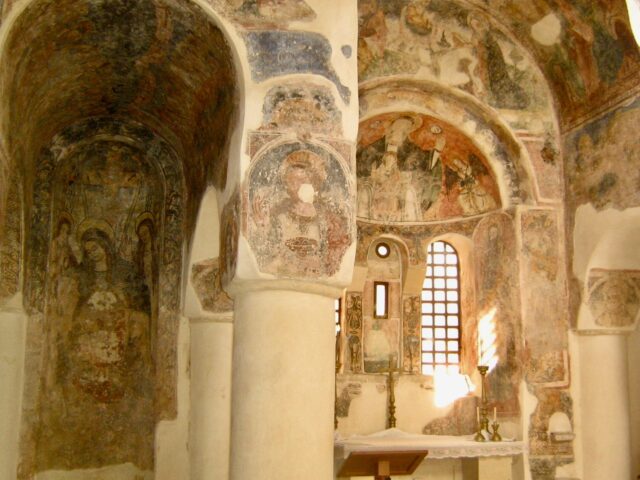Things to do in Otranto, Puglia

Table of Contents
Otranto is a coastal town in the region of Puglia in southern Italy, not far from the easternmost point of the Italian peninsula. My attention was first drawn to this town after seeing a stunning photo of its medieval walls fronting the Adriatic Sea. I researched the town and learned about its long and tumultuous history, stretching back to the 8th century B.C. (!), and made a note to visit it one day. During my trip to Puglia in May, I made sure to include Otranto in my itinerary and I stayed there for two nights. I discovered a gem of a town with an imposing castle, a maze of charming streets and an absolutely breathtaking waterfront. Read on to find out more about things to see and do in Otranto, and where to eat and stay.


A brief history of Otranto
Located about a 45-minute drive from Lecce (one of my favourite cities in Puglia), Otranto (map) is listed as one of the most beautiful towns in Italy. A Greek settlement in the 8th century B.C., Otranto was then occupied by the Romans. It became an important port and naval base due to its strategic location. In the centuries that followed, Otranto was invaded by the Byzantines, Ottomans, French and a host of other powers who vied to control the eastern Adriatic. The siege and occupation by the Ottomans in 1480, during which half the town’s population was killed, was especially gruesome. Otranto remained an attractive target right up to WWII.

These days, the town is, in my book, one of the best places to visit in Puglia. Otranto is famous for its castle, walled town, harbour front, sandy beaches and crystal-clear turquoise waters, making it absolutely worthwhile to visit. It’s especially busy during the hot, summer months, so I recommend visiting Otranto in spring (May-June) or autumn (September-October) when temperatures are more agreeable and there are fewer tourists. Here are my recommendations for things to see and do in Otranto:
Visit the Castle
The 15th century Castello Aragonese is an impressive sight. The perimeter is surrounded by a deep moat and its towers provide stunning views of the town and the harbour. Walk up to Torre Matta for lovely views of the old town walls and the sea.


Wander around the maze of streets in the old town
The old town, almost completely surrounded by thick walls, is comprised of a maze of cobblestone streets and alleys interspersed by little squares. There’s a plethora of shops, cafés, wine bars and restaurants as well as various historic sights.



Walk along the harbour front
Go for a stroll along the harbour front and sea-walls to truly appreciate Otranto’s stunning location. The views of the harbour, with its multiple hues of turquoise, and the medieval walls are absolutely beautiful. Start at the ‘La Villa‘ park – don’t miss the gorgeous ‘Il Pitosforo’ tree with its low-hanging canopy – and continue to Lungomare degli Eroi, the waterfront promenade.


From there, head for the Bastione dei Pelasgi (Pelasgian Bastion) and follow the wall along Via dei Bastioni to Torre Matta. The sea views are just stunning! On clear days, you’ll be able to see the mountains of Albania in the far distance.

Visit the Otranto Cathedral
The 11th century Cathedral, or Cattedrale di Santa Maria Annunziata, is one of the historic highlights of Otranto. Inside, you’ll find an exquisite 12th century mosaic floor and a gold-gilded ceiling.




The crypt is a solemn place, with 70 columns supporting beautiful arches. Here, you’ll find a shrine consisting of the skulls and bones of more than 800 citizens who were beheaded during the Ottoman Siege of Otranto (1480 A.D.) for refusing to convert to Islam. You’ll also find beautiful frescoes on some of the walls.


Admire the Byzantine frescoes
The Chiesa di San Pietro (Church of St. Peter) is a little church, tucked away in an alley above the Piazzetta de Ferraris square. Probably built in the 10th century A.D., the church is one of the southernmost Byzantine structures on the Italian peninsula. Inside, you’ll find some of the most treasured Byzantine frescoes in Puglia.

Enjoy the sea
Once you lay your eyes on that gorgeous sea in numerous shades of turquoise, you’ll definitely want to jump into its crystal-clear water. There are several places in the town from which the sea is accessible. Some are small, sandy beaches whilst others are little more than concrete paths that run along the medieval sea walls.

The nearest sandy beach is Spiaggia dei Gradoni (5-10 minute walk from the old town) which has various facilities like sun beds and bathrooms. There are also several beach clubs along this stretch of sand.

At the Lungomare degli Eroi, you’ll spot a small patch of sand called Spiaggetta del Molo (or Children’s Beach).

Under Lungomare degli Eroi, the concrete pathway and wave-breaker blocks are popular spots for the locals to sunbathe and enjoy the crystalline water.

Indulge in traditional Puglian cuisine
There are numerous restaurants in Otranto which serve terrific Puglian (sea)food and wines. In the old town, I recommend dining at Vicolo Matto Fishbar, L’ora di Mezzo and La Pignata.


A short drive away, north of Otranto, I had a fantastic seafood meal at Ristorante Agriturismo “Il Diavolicchio Goloso” (map).


Wake up to an amazing view
I stayed at Palazzo de Mori, a gorgeous hotel in the old town. The spacious rooms are scattered across various buildings and some boast terrific views of the harbour.

Each morning, I woke up, opened the windows and just gaped at the stunning sea view. One of my favourite moments there was breakfast on the terrace.

Parking
If you’re driving and staying in the old town, note that the old town is for pedestrians only. There are various paid and free parking lots located at the edges of the old town. If you’re staying in the old town such as Palazzo de Mori, I recommend parking on the street (paid) for 10 minutes and dropping off your bags at your hotel before re-parking your car at one of the long-term parking lots. Palazzo de Mori has its own parking area about a 10-minute walk from the hotel.
There are lots of places near Otranto that warrant a longer stay in the town. Just outside the town, you’ll find the old Bauxite Quarry, which has become a noteworthy attraction.

Just south of Otranto lies the easternmost point of Italy. This spot at Punta Palascia is marked by a lighthouse.

A bit further south, the Costa Otranto Regional Nature Park is a wild coastal area with grass hills that gently slope down to the sea. Visitors are able to hike to the Grotta della Macchia (caves) and Torre Sant’Emiliano, the remains of a medieval watchtower.

Just north of Otranto, the coast is home to some of the best beaches and most beautiful rock formations in Puglia. Baia dei Turchi, a wondrous stretch of white sand, is the most popular beach.

I also recommend a visit to Torre Sant’Andrea, a bit further north, to see its stunning rock formations. This area is also a popular swimming and sunbathing spot.





